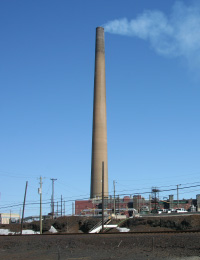 A proposed $1.5 to $2 billion Atmospheric Emission Reduction (AER) program at Vale’s Sudbury Operations is expected to receive board approval in October. Billed as “the largest environmental investment ever contemplated in Sudbury,” the AER will reduce sulphur dioxide emissions from the current level of 175,000 metric tonnes to 30,000 metric tonnes per year, less than half the Ontario government-mandated emission target of 66,000 metric tonnes.
A proposed $1.5 to $2 billion Atmospheric Emission Reduction (AER) program at Vale’s Sudbury Operations is expected to receive board approval in October. Billed as “the largest environmental investment ever contemplated in Sudbury,” the AER will reduce sulphur dioxide emissions from the current level of 175,000 metric tonnes to 30,000 metric tonnes per year, less than half the Ontario government-mandated emission target of 66,000 metric tonnes.
“It’s going to decrease our current emissions by approximately 80 per cent…and will ensure the ongoing sustainability of our operations,” said Angie Robson, manager of corporate affairs for the company’s Ontario Operations. The investment “is a clear signal that the Sudbury Operations matter to Vale and that there are many years (of mining) left in the Basin.”
The project is expected to get under way in 2012 and will create work for anywhere from 800 to 2,000 people onsite at the peak of construction.
Sulphur dioxide emissions from Vale’s Sudbury Operations have decreased dramatically since 1970, when they were just shy of two million metric tonnes per year. A series of abatement projects were carried out over the years by Vale forerunner Inco. In the early ’90s, the company replaced its reverberating furnaces with flash furnaces and “all that gas was captured and sent to an acid plant,” said Frank Javor, manager, environment air. “That project took five years to complete.”
In 2006, a fluid bed roaster sulphur dioxide abatement project “captured all the gas from those vessels, cleaned it, removed the dust and sent it to the acid plant.”
Converters
The abatement program planned for 2012 will focus on the converters, cylindrical vessels in the smelter that upgrade the nickel/copper content of the flash furnace matte. Currently, explained Javor, the gas from the converters goes through an electrostatic precipitator to remove dust and then goes up the company’s 380-metre superstack, the tallest smokestack in the Western Hemisphere.
The five current converters will be replaced by four new ones with tighter fitting hoods “to capture fugitive gases so they don’t go out through the rooftops,” said Javor.
“As part of the project in the converter aisle, there will be a huge amount of ducting and vessels to bring the gas to a gas cleaning facility which is really a combination of wet electrostatic precipitators and scrubbers. They will take the dust out of the gas and, from there, it will go to a brand new acid plant which will be located beside the existing one. There will also be a cooling tower for that acid plant and an extra storage tank.”
The company will maintain operations while the work is being carried out, adding significantly to the complexity of the project.
The first new converter will be built and installed with ducting going to the existing system “because when you build an acid plant, it’s sized for a certain amount of gas, so the new acid plant will be the last thing to be turned on,” said Javor. “We will have to have three converters built before we can do that. With one, you couldn’t operate it.
“Once we build and commission the first converter, we’ll tear out one of the old ones with all the associated steel work and start building the second one. All together, there will be four new converters.”
The Atmospheric Emission Reduction program addresses two standards. One is the Ontario government mandated total sulphur dioxide emission target of 66,000 metric tonnes that comes into force in 2015. The other set of regulations concerns ground level concentrations of sulphur dioxide and heavy metals sourced from low level stacks, rooftop fugitive emissions and roads. Approximately $1 billion will be spent to tackle total emissions. The rest will address ground level concentrations through secondary hooding on nickel converters and copper multi purpose vessels, additional state-of-the-art baghouses and collection systems, and enclosed material handling facilities for processing and storage of feeds.
Hydromet
According to Javor, a hydromet facility like the one Vale is building in Long Harbour, Newfoundland, wouldn’t be applicable to Sudbury.
“It would cost billions upon billions and has limitations,” he said. “One of the benefits we have with our technology in Sudbury is that it not only allows us to recover the nickel, but also the copper, the precious metals and the cobalt.”
Copper is becoming increasingly important to Vale worldwide, explained Robson. “If you look at our investment plans going forward, one of the things we’re very focused on is increasing copper production in the Basin.”
The AER program accounts for the lion’s share of the $3.4 billion the company plans to spend in Sudbury over the next five years.
Other capital spending projects include a $200 million investment in a state-of-the-art floatation system at Clarabelle Mill and $360 million to bring Totten Mine into production.
The company is also undertaking an aggressive exploration drilling program in zones of high copper and precious metal values, including its Victor and Capre properties. Combined, the mining studies and exploration expenditures in the Sudbury Basin account for an investment of more than $50 million in 2011.
www.inco-sudbury-airquality.com


